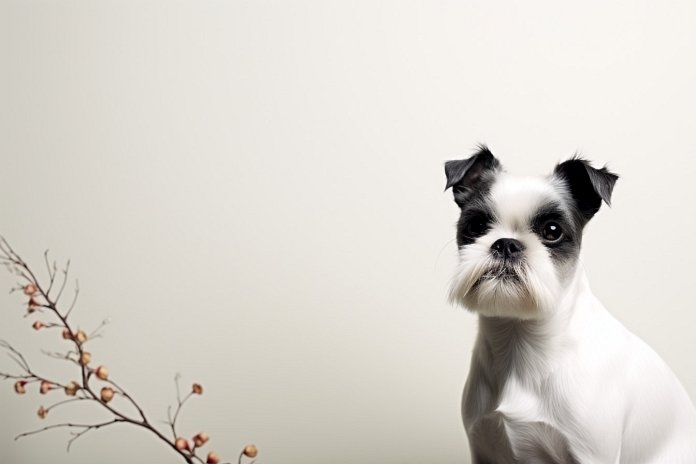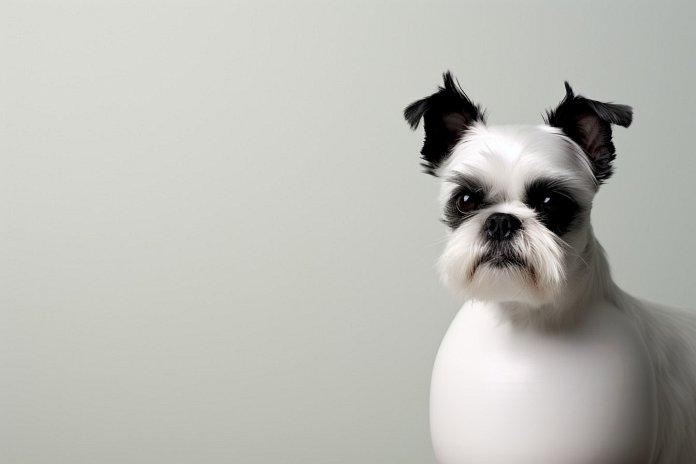
A Bostie is a wonderful companion dog that is known for being tenacious, active, and curious. They require moderate exercise and lots of love from their owners. On average, they live between 10 and 14 years, which is typical for small breed dogs. Bosties usually grow to be around 10 to 16 inches tall and weigh between 14 and 20 pounds. They have a small frame, resembling a Boston Terrier, with facial characteristics similar to a Westie. Their coat is typically long, black-and-white, and has a wiry texture. It’s important to note that while the Bostie is not officially recognized by the American Kennel Club, it can make a wonderful addition to a busy household.
Ahead, we look at Bostie dog breed, its history, personality, pros and cons of owning an Bostie, characteristics, and must-see facts. We will also examine how to care for this breed and a lot more. Prepare for a tail-wagging adventure into the world of Bosties!
| Dog Breed | Bostie |
| Size | Small |
| Weight | 13-18 lbs (average) |
| Height | 10-15″ (average) |
| Location | United States, Scotland, United Kingdom |
| Ancestry | Boston Terrier, West Highland White Terrier |
| Date of Origin | Unknown |
| Group | Companion |
| Life Expectancy | 12-16 years |
| Price | $900 – $1200 |
| Family | Canidae |
| Scientific Name | Canis Lupus Familiaris |
📖 Breed History
The Bostie, also known as the Boston Westie or Bostie Terrier, gets its name from its parent breeds, the Boston Terrier and the West Highland White Terrier or “Westie”. The Boston Terrier originated in Boston, Massachusetts and was brought to the United States from England in 1865. This breed was mixed with various dogs, including the French Bulldog, to create the beloved American breed we know today. From 1905 to 1939, the Boston Terrier was extremely popular in the United States and it has been recognized by the American Kennel Club since 1893.
The Westie, on the other hand, originated in Scotland during the time of King James I. It was bred to hunt foxes, badgers, and vermin. In the past, this breed was known by various names such as White Scottish, Little Skye, Cairn, and Roseneath Terriers. In 1908, it was officially registered as the Roseneath by the AKC, but the name was later changed to the West Highland White Terrier. Since then, it has become a popular pet and show dog.
The Bostie, a mix of these two breeds, has been unofficially bred since the early to mid-1900s. It has recently gained recognition as a designer hybrid, but it is not widely acknowledged or registered by the AKC.

🐕 Bostie Appearance
Bosties look like Boston Terriers and have Boston Terrier bodies. The breed has a tiny frame and a narrow snout. Bosties grow to be between 10 and 15 inches tall and weigh an average of 18 pounds. Like their Westie predecessors, they have long, thick, wiry coats. Bosties are primarily black and white, although they can also resemble other colors that Boston Terriers frequently exhibit, such as brindle and brown. Bosties are tenacious, as seen by their focused and resolute facial expressions. They have a scissor jaw, black eyes, and upright, triangular-shaped ears. Their generally robust, strong body is supported by rather short legs that culminate in rounded, cat-like paws.
| 👀 Eye Color | Brown |
| 🐽 Nose Color | Black |
| 🐕 Coat Color | Black, White, Brindle, Brown |
⚡ Fun Fact: Bostie dogs are a social breed. They enjoy being around people or other animals. This breed doesn’t tolerate being left alone.
🐶 Traits & Temperament of Bostie
Bosties are often content and sociable creatures that develop strong bonds with their owners. Although they are friendly and get along with kids, they might be a little reserved with unfamiliar people. They should be gradually introduced to new canines in a similar vein. However, once a Bostie gains a friend, they become extremely friendly and playful. The Bostie are ideal home pets and family members because to its kind demeanor. Bosties also get a strong feeling of independence from both of their parent breeds. They may be irritating for owners as a result since they can be challenging to train and rather demanding. If they grow agitated, bugs also have a tendency to bark and dig. The easiest approach to combat these inclinations is to subject Bosties to constant, attentive training from an early age. If abused, this breed, which may be sensitive, will soon develop timidity or shyness. As a result, Bosties thrive in loving and encouraging family settings.
🤝 Are Bosties Friendly or Aggressive?
Bostie dogs are known for their friendly nature towards other pets, strangers, and children. They enjoy being around kids and are generally accepting of cats and other dogs. If you are looking to add more dogs to your family or participate in dog meetups, the Bostie breed is a great option as they are highly dog-friendly. Additionally, Bosties are considered one of the best breeds for elderly individuals, as they are well-suited to provide companionship and support in their later years.
This breed is known for being:
- Playful
- Independent
- Alert
- Courageous
- Intelligent
- Friendly
- Affectionate
- Lively
- Gentle
- Aggressive
🐩 Bostie Care & Maintenance
Bosties’ hair-like coat, which they get from their Westie father, helps them create less allergies even if they are not entirely hypoallergenic. Bosties should have their long coats groomed frequently since they are prone to matting and tangling. In order to prevent infections around the eyes and ears, owners should also give their Bosties regular baths and clip their hair. Some Bosties will require routine plucking and stripping to maintain a healthy coat. Similar to other breeds, Bosties should have their nails clipped once or twice a month to avoid uncomfortable overgrowth, ripping, or splitting.
Bostie dogs are known for being low shedders, meaning they do not lose a lot of hair. This is a natural part of their hair growth cycle. The amount and frequency of hair loss can vary depending on the dog’s overall health and the specific breed they belong to. When it comes to bath time, Bostie dogs typically require a bath every 4-6 weeks to keep them clean and maintain their coat’s health.
🍖 Food: We recommend 1 cups daily, costing you about $0.75 – $1.00 daily, or around $20.00 – $30.00 a month.
🐾 Exercise: Bostie dogs need quite a lot of exercise. Daily walks should be on schedule. If you live an active life, this breed can be a good choice for you.
This dog breed requires to be walked for roughly 6 miles per week, which equates to about 60 minutes of physical activity daily. This consistent moderate exercise regimen will help maintain their physical wellness and significantly contribute to their mental stimulation. Consciously setting aside this time for your furry friend can dramatically enhance their life quality, helping them stay energetic, healthy, and mentally alert.
Did you know: Bostie dogs have a higher energy level than other dog breeds. If you want a dog for snuggling on the couch, this breed isn’t the perfect choice for you.
❤️🩹 Bostie Health & Issues
Some of the major concerns for Bostie Dog Breed can be:
- Patellar Luxation
- Globoid Cell Leukodystrophy
- Legg-Calve-Perthes Disease
- Craniomandibular Osteopathy
While minor concerns include:
- Deafness
- Cataracts
- Copper Poisoning
🤧 Important: Is Bostie hypoallergenic? No.
✨ Bonus: Check out cool, creative, and funny names for Bostie.
⚡ Bostie Dog Breed Facts
What makes the Bostie a great choice for families with young children?
The Bostie’s happy and social nature makes them a great choice for families with young children. They are outgoing and get along well with children, making them excellent playmates and companions.
Is the Bostie breed considered a suitable breed for apartment living?
Yes, the Bostie breed is considered suitable for apartment living. They require a moderate amount of activity, which can easily be met with daily walks and playtime indoors.
How much exercise does a Bostie require compared to other breeds?
Compared to some other breeds, Bosties require a moderate amount of exercise. Daily walks and playtime should be sufficient to keep them happy and healthy.
Is the Bostie breed known for being good with other pets?
Bosties are generally good with other pets, but they should be introduced to new dogs slowly. Once they make a friend, they are affable and playful.
What are other low-maintenance dog breeds similar to the Bostie?
Some low-maintenance dog breeds similar to the Bostie include the French Bulldog, Cavalier King Charles Spaniel, and Pug. These breeds also have friendly dispositions and require moderate exercise.
What are the common health issues that Bosties are prone to?
Bosties are generally healthy dogs, but they may be prone to health issues common in their parent breeds, such as allergies, skin problems, and respiratory issues.
Are Bosties known to be easy to train compared to other breeds?
Bosties can be challenging to train due to their independent nature. Consistent and early training is essential for this breed.
Are Bosties more prone to separation anxiety compared to other breeds?
Bosties can be prone to separation anxiety if not properly trained and socialized. They do best in homes where they receive plenty of affection and reassurance.
Are there any dog breeds similar to the Bostie that are suitable for people with allergies?
Some dog breeds similar to the Bostie that are suitable for people with allergies include the Bichon Frise, Maltese, and Portuguese Water Dog. These breeds have hypoallergenic coats that produce fewer allergens.
What sizes of dogs similar to the Bostie are best for individuals or families with limited space?
Small-sized dog breeds similar to the Bostie, such as the French Bulldog, Cavalier King Charles Spaniel, and Pug, are best for individuals or families with limited space.
Is the Bostie breed known to be good with children with special needs?
Bosties are generally good with children, including those with special needs. However, as with any dog, supervision and proper introductions are important to ensure safety and compatibility.
How does the grooming and shedding needs of the Bostie?
The Bostie’s grooming needs are moderate. Their wiry coat requires regular brushing to prevent matting, and occasional professional grooming may be needed. They are average shedders compared to some other breeds.
We use reliable and publicly available data and resources such as AKC and American Canine Registry to ensure that Bostie dog breed information is accurate and up to date. If you spot an error, please don’t hesitate to bring it to our attention.